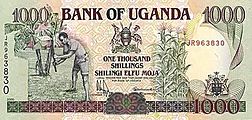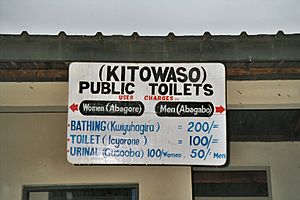Ugandan shilling facts for kids
Quick facts for kids Ugandan shilling |
|||
|---|---|---|---|
|
|||
| ISO 4217 Code | UGX | ||
| User(s) | |||
| Inflation | 4.7% | ||
| Source | The World Factbook, 2014 est. | ||
| Coins | |||
| Freq. used | 100/=, 200/=, 500/=, 1,000/= | ||
| Rarely used | 50/= | ||
| Banknotes | 1,000/=, 2,000/=, 5,000/=, 10,000/=, 20,000/=, 50,000/= | ||
The shilling (Swahili: shilingi; abbreviation: USh; ISO code: UGX) is the official money of Uganda. Until 2013, it was officially divided into smaller units called cents. However, because of a lot of price increases (inflation), the shilling no longer has these smaller parts.
Contents
How to Write Ugandan Shilling Prices
When you see prices in Ugandan shillings, they are often written as x/y
For example, 50 cents is written as "-/50". One hundred shillings can be written as "100/=" or "100/-". Sometimes, people add "USh" before the number to make it clear it's Ugandan shillings. For instance, USh 10 million. This way of writing prices is similar to how the British Pound sterling used to be written.
History of the Ugandan Shilling
The first Ugandan shilling (UGS) was created in 1966. It replaced the East African shilling at the same value. Later, because prices kept going up quickly (high inflation), a new shilling (UGX) was introduced in 1987. This new shilling was worth 100 old shillings.
The Ugandan shilling is usually a strong and steady currency. Most money deals in Uganda use the shilling. Uganda also has a good system for exchanging foreign money. The United States dollar is also often used in Uganda. The British Pound sterling and the euro are becoming more common too.
In 2012, the Bank of Uganda lowered its main interest rate to 22%. This happened after prices stopped rising so fast for three months in a row.
Ugandan Shilling Coins
Uganda has used different coins over the years.
First Shilling Coins (1966-1986)
In 1966, the first coins were made. These included values like 5, 10, 20, and 50 cents, and 1 and 2 shillings. The smaller cent coins were made of bronze. The higher value coins were made of a mix of copper and nickel. The 2-shilling coin was only made in 1966.
In 1972, 5-shilling coins were made, but they were quickly taken out of use and are now very rare. Later, in 1976, some coins started to be made with steel coated in copper or copper-nickel. This was cheaper. The last coins of the first shilling were made in 1986.
| First Ugandan shilling coins | |||||||
|---|---|---|---|---|---|---|---|
| Image | Value | Material | Diameter | Weight | Thickness | Edge | Issued |
 |
-/5 | bronze | 20 mm | 3.21 g | 1.38 mm | Smooth | 1966–1975 |
| -/5 | bronze-plated steel | 20 mm | 3.21 g | 1.2 mm | Smooth | 1976 | |
 |
-/10 | bronze | 25 mm | 5 g | 1.5 mm | Smooth | 1966–1975 |
| -/10 | bronze-plated steel | 25 mm | 4.5 g | 1.5 mm | Smooth | 1976 | |
 |
-/20 | bronze | 28 mm | 9.76 g | 2.07 mm | Smooth | 1966–1974 |
| -/50 | copper-nickel | 22 mm | 4.60 g | 1.5 mm | Reeded | 1966–1974 | |
| -/50 | copper-nickel-plated steel | 22 mm | 4 g | 1.5 mm | Reeded | 1976 | |
| 1/= | copper-nickel | 25.5 mm | 6.50 g | 1.5 mm | Reeded | 1966–1975 | |
| 1/= | copper-nickel-plated steel | 25.5 mm | 6.50 g | 1.5 mm | Reeded | 1976 | |
 |
2/= | copper-nickel | 30 mm | 11.7 g | 1.5 mm | Reeded | 1976 |
| 5/= | copper-nickel | 30 mm (heptagonal) | 13.5 g | 2 mm | Smooth | 1976 | |
Second Shilling Coins (1987-Present)
In 1987, new coins were made for the second shilling. These included 1 and 2 shillings made of copper-plated steel. There were also 5 and 10 shilling coins made of stainless steel. The 5 and 10 shilling coins had a special curved seven-sided shape.
In 1998, coins for 50, 100, 200, and 500 shillings were introduced. Today, the coins you will most often see are 50, 100, 200, 500, and 1,000 shillings.
| Second Ugandan shilling coins | ||||||||
|---|---|---|---|---|---|---|---|---|
| Image | Value | Material | Reverse design | Diameter | Weight | Thickness | Edge | Issued |
| 50/= | Nickel-plated Steel | Ankole-Watusi | 21 mm | 3.9 g | 1.8 mm | Smooth | 1998–2015 | |
| 100/= | Copper-nickel | 27 mm | 7 g | 1.73 mm | Reeded | 1998–2008 | ||
| Nickel-plated Steel | 27 mm | 6.6 g | 1.73 mm | Reeded | 2007–2019 | |||
| 200/= | Nile perch | 25 mm | 8.5 g | 2.05 mm | Smooth | 1998–2003 | ||
| Nickel-plated Steel | 25 mm | 7.25 g | 2.05 mm | Smooth | 2007–2019 | |||
| 500/= | Aluminum-brass | East African crowned crane | 23.5 mm | 9 g | 2.9 mm | Reeded | 1998–2019 | |
| 1,000/= | Bi-Metallic nickel-brass plated nickel center in nickel-brass ring | 27 mm | 10.25 g | 3 mm | Reeded | 2012 | ||
Ugandan Shilling Banknotes
Banknotes are the paper money used in Uganda.
First Shilling Banknotes
In 1966, the Bank of Uganda started printing banknotes. These were in values of 5, 10, 20, and 100 shillings. Later, in 1973, 50-shilling notes were added. Even higher values like 500 and 1,000 shillings came out in 1983. Finally, a 5,000-shilling note was introduced in 1985.
Second Shilling Banknotes
When the new currency was introduced in 1987, new banknotes were also printed. These included 5, 10, 20, 50, 100, and 200 shillings. Over time, more values were added: 500 and 1,000 shillings in 1991, 5,000 shillings in 1993, and 10,000 shillings in 1995. Even larger notes like 20,000 shillings (1999) and 50,000 shillings (2003) followed. A 2,000-shilling note was added in 2010.
Today, the banknotes you will find are 1,000, 2,000, 5,000, 10,000, 20,000, and 50,000 shillings. The Bank of Uganda once thought about replacing the smaller notes, like the 1,000 shilling note, with coins. This is because low-value notes get very worn out and dirty from daily use.
On May 17, 2010, the Bank of Uganda released a brand new set of banknotes. These new notes have a similar design across all values. They show off Uganda's rich history, beautiful nature, and cultural traditions. They also have better security features to prevent fake money.
All six types of notes feature five common images. These include Ugandan mat patterns, Ugandan basketry, a map of Uganda with the equator line, the Independence Monument, and a profile of a man wearing a Karimojong headdress. The head of the Bank of Uganda, Emmanuel Tumusiime Mutebile, said the new notes were not a big change to the money system. He also said they were not made for political reasons. The main goal was to follow international rules and stop people from making fake money. Uganda was the first country in Africa to use a special security feature called SPARK on its regular banknotes. SPARK is a special visual feature that central banks around the world trust to protect against fake money.
Exchange Rates
| Current UGX exchange rates | |
|---|---|
| From Google Finance: | AUD CAD CHF EUR GBP HKD JPY USD KYS ZAR |
| From Yahoo! Finance: | AUD CAD CHF EUR GBP HKD JPY USD KYS ZAR |
| From XE.com: | AUD CAD CHF EUR GBP HKD JPY USD KYS ZAR |
| From OANDA: | AUD CAD CHF EUR GBP HKD JPY USD KYS ZAR |
| From fxtop.com: | AUD CAD CHF EUR GBP HKD JPY USD KYS ZAR |
See also
- Economy of Uganda
- Kenyan shilling
- Tanzanian shilling



